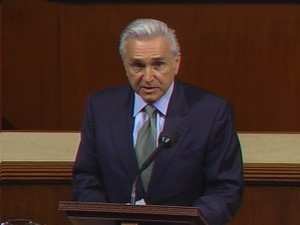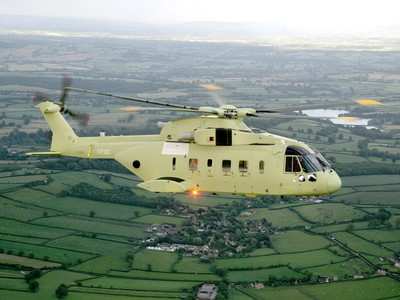$100 Million for Lockheed Martin to Continue Developing
Technology For New Presidential Helicopter
 The U. S. House of
Representatives passed an FY2010 defense appropriations bill
Wednesday which includes $100 million to allow Lockheed Martin to
continue developing the technology for a new presidential
helicopter fleet.
The U. S. House of
Representatives passed an FY2010 defense appropriations bill
Wednesday which includes $100 million to allow Lockheed Martin to
continue developing the technology for a new presidential
helicopter fleet.
Representative Maurice Hinchey (D-NY), a member of the House
Appropriations Subcommittee on Defense and who represents the
district that includes Lockheed's Owego factory where the work is
being done, had successfully argued for $485.2 million for the
presidential helicopter program when the House passed its version
of the bill in July, but the Senate failed to include any money for
the project. Now that the House has approved the funds in the
conference report, the bill moves to the Senate where it is
expected to be taken up and voted on in the coming days.
"We have overcome extraordinary odds to reach this moment,"
Hinchey said. "While I certainly would have preferred the House
level of funding to be in the final version of the bill, the $100
million we approved today will continue the development of a new
fleet of presidential helicopters, build on the $1.1 billion
already spent on systems work, and ensure that approximately 250
people in the Southern Tier of New York don't lose their jobs. I
will continue to press the Pentagon and White House very hard to
complete the development of the VH-71 helicopter because doing so
is in the best interests of the American taxpayers and the safety
of our president. A modified VH-71 helicopter fleet would maximize
the significant investment already made in developing the
helicopter while stripping away billions in cost overruns that were
allowed to develop under the previous administration."

Representative Maurice
Hinchey
The $100 million in the final version of the fiscal year 2010
Defense Appropriations bill will save approximately 250 jobs at
Lockheed Martin's plant in Owego, New York. The funds will allow
the company to continue developing communications equipment and
computer software that will be used in the next fleet of
presidential helicopter. Earlier this year, the Pentagon cancelled
the two-phased VH-71 program because it claimed the project became
too expensive, but Hinchey said he and others later learned from
internal Navy documents that the Pentagon's new plan for a
presidential helicopter program would cost up to three times as
much as a proposed compromise solution, and take 12 years longer to
complete.
The Navy is continuing to review its options for a new
presidential helicopter fleet, including a modified version of
Lockheed Martin's VH-71. Hinchey is still advocating a compromise
plan for the Pentagon's consideration that would eventually produce
an expanded fleet of VH-71 Increment 1 helicopters, which are
already so far along in development that they have flown more than
800 hours of test flights. That expanded fleet could be delivered
within or close to the original contract's budget. Regardless, the
$100 million included in the bill approved today will be used for
technology that can be used in the next fleet of presidential
helicopters, no matter which company constructs the actual
helicopters.
"This $100 million allocation will continue work at Lockheed
Martin's Owego branch and position the company to continue its
involvement as the lead company involved in producing the next
presidential helicopter fleet," Hinchey said. "While it made no
sense for the Pentagon to have cancelled the VH-71 earlier this
year, it can still do the right thing by deciding to go with a
modified VH-71 program, which would make the best use of the
taxpayer money already invested in the program while also producing
a new fleet in the timeliest fashion possible. This modified
proposal is something I've been advocating since March and it
provides a way for the Pentagon to reject the original contract
while embracing a responsible alternative."

VH-71
Hinchey had put the $485.2 million in the House version of the
bill to continue the development of the first phase of the
presidential helicopter program, known as VH-71A or Increment 1.
The funding would not have been used for the more costly phase
known as Increment 2, which is the aspect of the program that has
come under fire. The $100 million in the House's agreement with the
Senate will be used for broader presidential helicopter work.
"The continued development of Increment 1 would avert a
misguided plan to start over from scratch with a more expensive
helicopter program that would also force the continued use of the
current, outdated presidential helicopter fleet, which was designed
in the 1950's and constructed in the 1970's," Hinchey said. "A new
fleet of VH-71 Increment 1 helicopters would provide the White
House with state-of-the-art helicopters that would keep this and
future presidents safe and it would do so in the most
cost-effective way possible."
According to the Congressional Research Service, internal Navy
documents show that the proposed presidential helicopter program to
replace the VH-71 program would cost $15-22 billion when factoring
in the $4 billion already spent on the canceled VH-71 program and
$1.2 billion needed to keep the fleet currently used by the White
House operational.
A separate set of internal Navy documents reveal that the
Pentagon's new presidential helicopter plans call for aircraft that
have nearly identical capabilities as the VH-71 program while
taking 12 years longer to deliver. That delay in delivery would
force the Navy to perform another Service Life Extension Program
(SLEP) on the current in-service fleet in order to keep it
operating while the Pentagon waits for the delivery of the new
helicopters. That life extension would cost an additional $1.2
billion
 NTSB Final Report: Rutan Long-EZ
NTSB Final Report: Rutan Long-EZ ANN FAQ: Turn On Post Notifications
ANN FAQ: Turn On Post Notifications Classic Aero-TV: ICAS Perspectives - Advice for New Air Show Performers
Classic Aero-TV: ICAS Perspectives - Advice for New Air Show Performers ANN's Daily Aero-Linx (06.28.25)
ANN's Daily Aero-Linx (06.28.25) Aero-News: Quote of the Day (06.28.25)
Aero-News: Quote of the Day (06.28.25)





